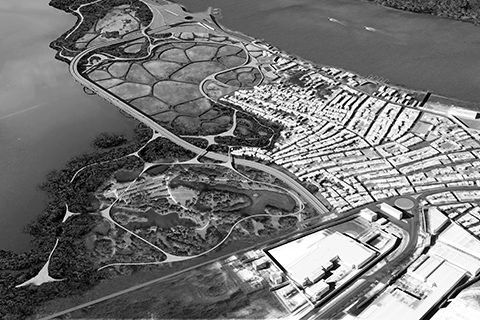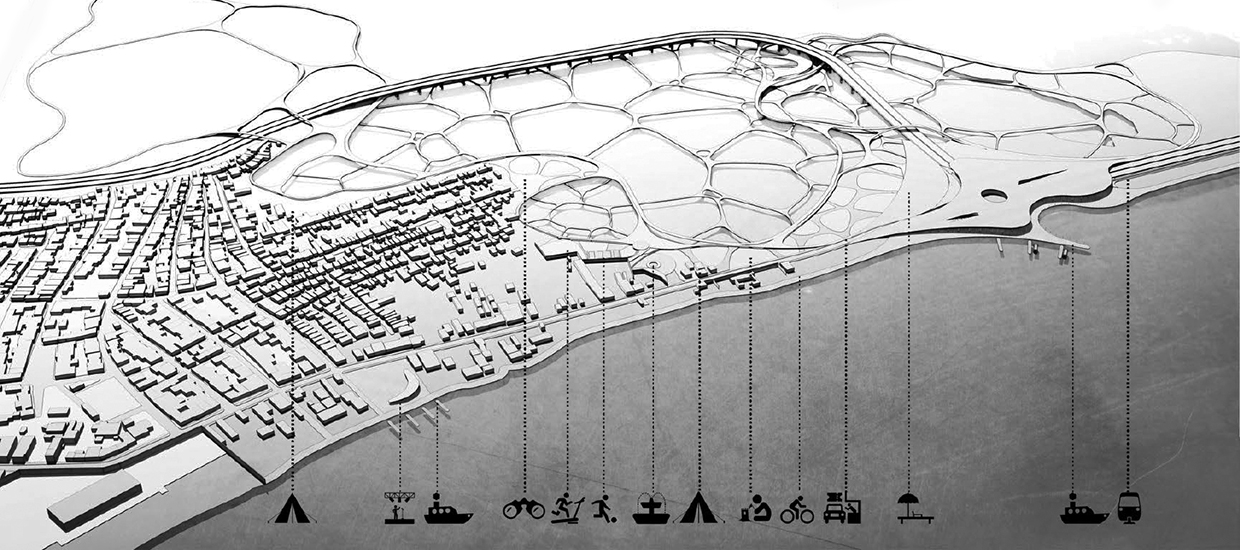The Master of Urban Design (1-year, 3-semester) was created in 1989 as the Master in Suburb & Town Design; under the new name, the curriculum has been revised to both maintain the unique identity of the original curriculum as a New Urbanism-oriented program, and to open it to new issues and challenges for the 21st century such as landscape urbanism and informal cities.
Studios are accompanied with seminars in planning law, history of cities, housing and infrastructure, and theory. The 36-credit track is designed for students with a degree in architecture; however, applicants with a landscape architecture or an accredited planning degree are eligible, (subject to satisfactory completion of a required preparation Summer course). Students can also opt to develop an additional 6-credit urban design thesis.
Urban design is remodeling, adding, subtracting, reworking, relating, and reforming three-dimensional spaces for human activities, including all pedestrian and vehicular systems. Urban design deals with the old and the new, the expanded and the contracted, the humdrum and the extraordinary. It brings people together. It separates people. It commemorates its history. It never lies, but portrays life three-dimensionally as it really is. At its best, it creates related and usable exterior spaces, provides means of “getting there” and a “there” once you are “there.”
It is the mother art of civilization, for it allows and, indeed, demand ideas, thinking, reactions to opportunities of the moment, executed in the spirit of its time, but demands respect for its earlier efforts. The new depends on the old and is responsible for the future. If the old is ignored, misunderstood, the future will mock the seemingly new and reveal for all the plainly see the false thinking expressed. All the other arts are handmaidens to urban design.
— Paul Rudolph, L’arca, nº 62, July/Aug., 1992. Paul Rudolph, Writings on Architecture, Yale University Press, 2008.
The core of the curriculum is the sequence of three Urban Design studios, preparing graduate students to study and work in major cities and regions of the U.S. and around the world. Recent studios have focused on the redevelopment of urban spaces in China, Italy, Germany, Colombia, the Near-East, and earthquake-ravaged Haiti.
The curriculum starts with an introductory studio (URB 601) and a parallel seminar (ARC 621); both focus on the study and analysis of major principles of urban design (public space, typology, regional networks, density, typical dimensions, landscape systems, generative codes, best practices, etc). The Spring semester (URB 602) deals with issues of re-urbanization and repair of neighborhoods, urban and suburban centers; students learn how to use infrastructure, housing, and mixed-use to be vectors for urban densification. The Summer semester (URB 603) is the “capstone” semester, focusing on a foreign city and allowing students and faculty to explore larger scale issues such as waterfront redevelopment, foundations of new towns and cities, impact of global warming, informal urbanism, etc.
To support the design process, two 1-credit Media (ARC 615 & 616) courses help students develop their design and representation skills to communicate ideas, concepts and design solutions. An additional 1-credit course (ARC 617) permits the participation of the Master of Urban Design students and faculty in the national Urban Land Institute Hines competition, to obtain a Certificate of completion from the National Charrette Institute.
Students follow additional seminars on housing and infrastructure (ARC622), history of urban form (ARC 590), and Introduction to Planning Laws and Real Estate. Two additional electives allow the students to choose courses throughout the School of Architecture and other University offerings. The program ends with an urban design charrette: for 4 to 7 days, students, faculty, public officials, stakeholders and residents share their approach and vision for a specific city or community, develop a variety of large-scale and small-scale plans and ideas, and present them for general input and potential implementation. Upon their return to Miami, students complete a final report in collaboration with their faculty and Master of Real Estate + Urbanism faculty and students.
The Master of Urban Design is open to applicants with Bachelors or Master degrees in landscape architecture or planning. The selected students are required to take an introductory 4-week preparation course before the beginning of the Fall semester (approx. July 15 – August 15). The intensive course teaches basic principles architecture, urban conventions, typology, and also serves as an introduction to graphic techniques and representation methods. The course meets 9 hours per week for one-credit tuition. Additionally, those students will be required to choose a Media course (Media II or advanced) or an Architectural History course as elective during the Spring semester.
Plan of Study Grid
|
FALL I |
Credit Hours |
| ARC 601 |
Urban Design I: Urban Form and Types/Form-Based Codes |
6 |
| ARC 621 |
History-Theory II: Housing, Transportation and Infraestructure. |
3 |
| ARC 690 |
History of Cities |
3 |
| RED 601 |
Introduction to Real Estate Development and Urbanism. |
3 |
| |
Credit Hours |
15 |
|
Spring I |
|
| ARC 602 |
Urban Design II: General Urban to Urban Core. |
6 |
| ARC 622 |
History-Theory III: Urban Design Theory. |
3 |
| RED 640 |
National Charrette Institute (NCI) |
1 |
| Elective |
3 |
| |
Credit Hours |
13 |
|
Summer I |
|
| ARC 603 |
Urban Design III: Regional/Informal Urbanism. Rome Studio* |
6 |
| ARC 623 |
Public Participation Methods - Charrette with MRED+U Program. |
2 |
| |
Credit Hours |
8 |
|
Fall II |
|
| ARC 604 |
Architecture Design and Theory I (Optional Thesis Track ) |
6 |
| |
Credit Hours |
6 |
|
Summmer( Rome-Miami 2nd Summer Session) |
|
|
Semester 1 |
|
| ARC 601 |
Urban Design I: Urban Form and Types/Form-Based Codes |
6 |
| ARC 615 |
Visualization Techniques |
1 |
| |
Credit Hours |
7 |
|
Fall II |
|
|
Semester 2 |
|
| ARC 602 |
Urban Design II: General Urban to Urban Core. |
6 |
| ARC 590 |
History of Cities |
3 |
| ARC 621 |
History-Theory II: Housing, Transportation and Infraestructure. |
3 |
| RED 601 |
Introduction to Real Estate Development and Urbanism. |
3 |
| |
Credit Hours |
15 |
|
Spring |
|
|
Semester 2 |
|
| ARC 603 |
Urban Design III: Regional/Informal Urbanism. |
6 |
| ARC 541 |
Seminar on Town Design |
3 |
| ARC 622 |
History-Theory III: Urban Design Theory. |
3 |
| ARC 623 |
Public Participation Methods - Charrette with MRED+U Program. |
2 |
| |
Credit Hours |
14 |
| |
Total Credit Hours |
78 |





